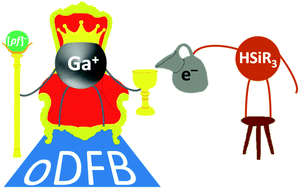Ga+-catalyzed hydrosilylation? About the surprising system Ga+/HSiR3/olefin, proof of oxidation with subvalent Ga+ and silylium catalysis with perfluoroalkoxyaluminate anions†‡
Abstract
Already 1 mol% of subvalent [Ga(PhF)2]+[pf]− ([pf]− = [Al(ORF)4]−, RF = C(CF3)3) initiates the hydrosilylation of olefinic double bonds under mild conditions. Reactions with HSiMe3 and HSiEt3 as substrates efficiently yield anti-Markovnikov and anti-addition products, while bulkier substrates such as HSiiPr3 are less reactive. Investigating the underlying mechanism by gas chromatography and STEM analysis, we unexpectedly found that H2 and metallic Ga0 formed. Without the addition of olefins, the formation of R3Si–F–Al(ORF)3 (R = alkyl), a typical degradation product of the [pf]− anion in the presence of a small silylium ion, was observed. Electrochemical analysis revealed a surprisingly high oxidation potential of univalent [Ga(PhF)2]+[pf]− in weakly coordinating, but polar ortho-difluorobenzene of E1/2(Ga+/Ga0; oDFB) = +0.26–0.37 V vs. Fc+/Fc (depending on the scan rate). Apparently, subvalent Ga+, mainly known as a reductant, initially oxidizes the silane and generates a highly electrophilic, silane-supported, silylium ion representing the actual catalyst. Consequently, the [Ga(PhF)2]+[pf]−/HSiEt3 system also hydrodefluorinates C(sp3)–F bonds in 1-fluoroadamantane, 1-fluorobutane and PhCF3 at room temperature. In addition, both catalytic reactions may be initiated using only 0.2 mol% of [Ph3C]+[pf]− as a silylium ion-generating initiator. These results indicate that silylium ion catalysis is possible with the straightforward accessible weakly coordinating [pf]− anion. Apparently, the kinetics of hydrosilylation and hydrodefluorination are faster than that of anion degradation under ambient conditions. These findings open up new windows for main group catalysis.



 Please wait while we load your content...
Please wait while we load your content...